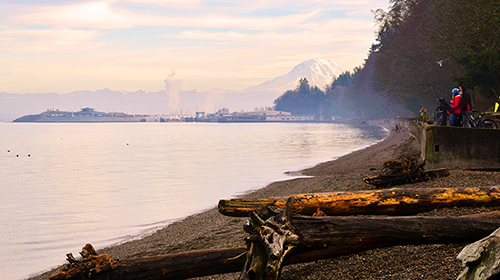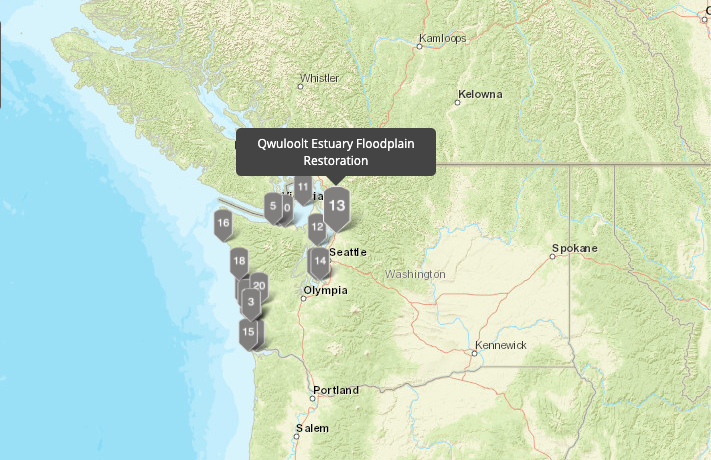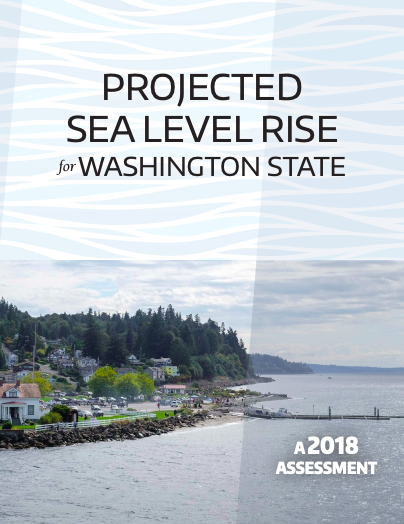
Read our feature stories covering this project:
Reimagining Our Future Shorelines – Sea Star Winter 2021
Under High Water – Sea Star Summer 2019
Read other articles covering this project:
Report shows detailed projections for Washington rising seas – Associated Press 2018
New science helps coastal communities plan for rising seas – Nature Conservancy 2018
Study shows 2 feet of sea level rise likely for Skagit by 2100 – Go Skagit 2018
Study examines projections for rise in sea level – South Whidbey Record 2018
Principal Investigator
Russell Callender, Washington Sea Grant
Co-Principal Investigators and Team Members
Ian Miller, Coastal Hazards Specialist, Washington Sea Grant
Nicole Faghin, Coastal Management Specialist, Washington Sea Grant
Paul Dye, Assistant Director for Outreach, Washington Sea Grant
MaryAnn Wagner, Assistant Director for Communications, Washington Sea Grant
Karen Morrill-McClure, IT, Accessibility and Inclusion Lead, Washington Sea Grant
Jackson Blalock, Community Engagement Specialist, Washington Sea Grant
Guillaume Mauger, Research Scientist, UW Climate Impacts Group
Crystal Raymond, Research Scientist, UW Climate Impacts Group
Harriet Morgan, Research Scientist, UW Climate Impacts Group
Heidi Roop, Lead Scientist for Science Communication, UW Climate Impacts Group
Brian Lynn, Coastal and Shorelines Manager, Washington Department of Ecology
Bobbak Talebi, Coastal Program Planner, Washington Department of Ecology
Eric Grossman, Research Geologist, U.S. Geological Survey
Jodie Toft, Director of Marine Conservation, The Nature Conservancy
Molly Bogeberg, Marine Conservation Manager, The Nature Conservancy
Other partners: University of Oregon, Washington Department of Fish Wildlife, UW Earth &
Space Sciences, NOAA Office for Coastal Management, Padilla Bay National Estuary Research
Reserve, City of Tacoma, Island County, WSG Hershman Fellows
Project
Coastal flooding, wave damage and shoreline erosion will increase as climate change continues to raise sea levels and create more severe storms along Washington’s coast. Washington’s Coastal Resilience Project was a three-year effort to rapidly increase the state’s capacity to prepare for natural events that threaten the coast. The project improved risk projections and provides better guidance for land use planners and strengthen capital investment programs for coastal restoration and infrastructure. These are the tools that coastal communities need to become more resilient to disasters.
Research
Background
Washington communities have experienced impacts associated with coastal erosion, flooding, landslides, and the looming threat of a catastrophic earthquake and tsunami for decades. While risk assessment has improved with science and technology, local emergency managers and planners have been overwhelmed by 1) Uncoordinated and confusing information about their risk and mitigation measures and 2) The litany of separate but related planning processes to help address impacts on their communities. There has been general recognition among agencies that in order to provide helpful assistance to local governments, a coordinated approach is needed.
Washington State Department of Ecology and Washington Sea Grant responded by establishing the Coastal Hazards Resilience Network (CHRN) in 2013. With seed funding from NOAA, the agencies have partnered to create a structured mechanism to share resources, best available science, tools, best practices and lessons learned among researchers, government agencies, academic institutions and end users. CHRN members attend annual meetings, current events and best practices through the CHRN blog, distribute opportunities for learning and skills development on the listserv, and use the CHRN website for coordinating and disseminating products from multi-partner projects. By maintaining a community of practice, Washington State is moving in a cohesive direction to help address existing and future threats.
Building upon this foundation, the Washington Coastal Resilience Project (WCRP) was funded by NOAA to address concerns about the ability of Washington State coastal communities to respond to the natural weather events that impact their shorelines.
Results
The WCRP team selected CHRN as the ideal portal site to house the many products produced by this prolific undertaking, now located under Sea Level Rise. Other materials may also be found on the Climate Impacts Group site.
The WCRP research team created the Washington Coastal Hazards Risk Reduction Mapper, showing projects that mitigate hazard risks related to erosion, flooding, landslides, and tsunamis.

Another key product of the Washington Coastal Resilience Project is the Projected Sea Level Rise for Washington State 2018 Assessment, which provides an updated set of sea level rise projections that incorporates the latest science, provides community-scale projections, and is designed for direct application to risk management and planning. Climate Impacts Group and Washington Sea Grant, with support from the Washington State Department of Ecology provide instructions on how to use the report in the How To Choose document, and via tutorials originally presented as part of a July 2020 Shoreline and Coastal Planners Group webinar, available here.
To see the full suite of products produced for the WCRP go to CHRN/ Sea Level Rise where all final materials are featured.
